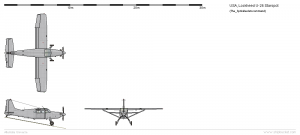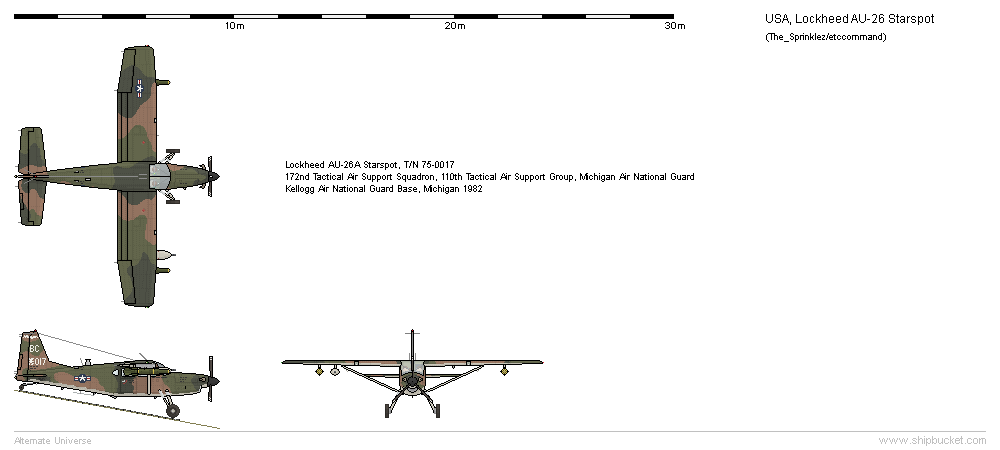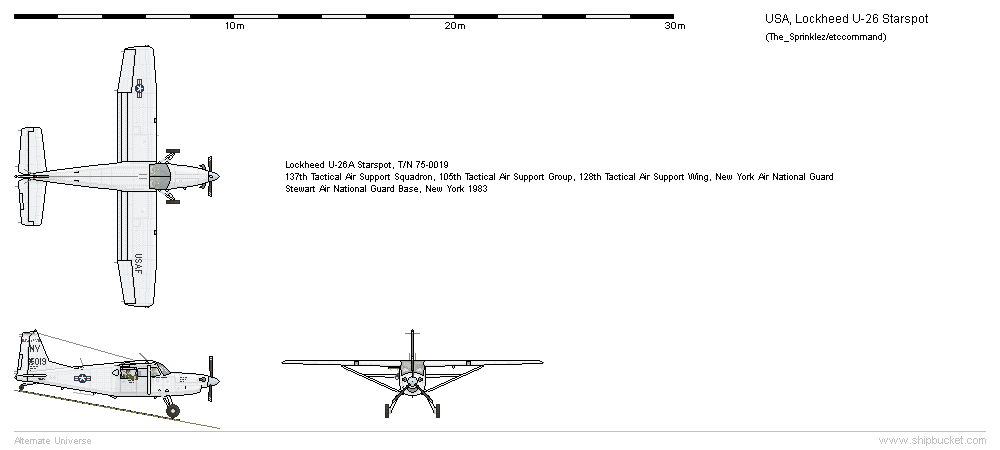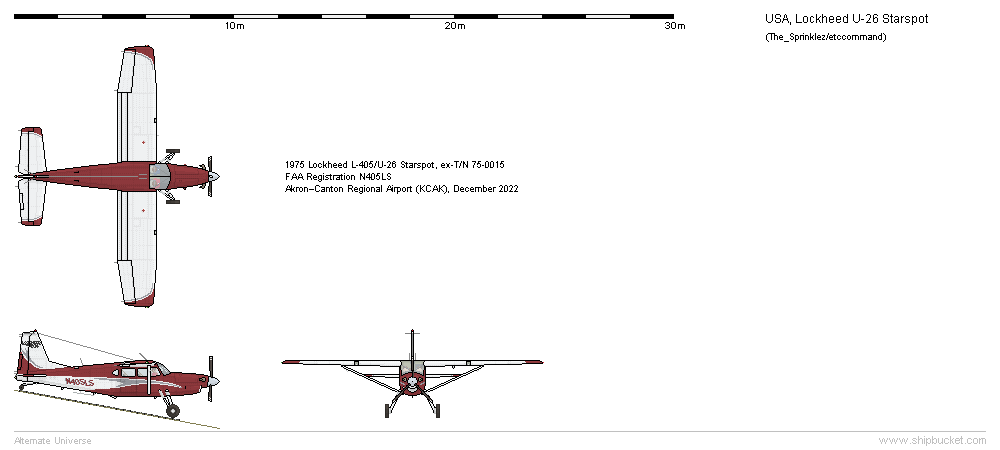Difference between revisions of "Lockheed U-26 Starspot"
m |
|||
| Line 30: | Line 30: | ||
The new aircraft, now bearing the company designation L-405, first flew on 13 April 1973 for a crowd of Lockheed and US Air Force VIPs. By this point, the USAF had long since concluded their Credible Chase program and was no longer interested in the aircraft for the RVNAF. However, the USAF was now interested in the possibility of using the much lighter L-405 themselves, both as a light attack platform as well as observation aircraft. With this goal in mind, and with some “convincing” from Lockheed executives, the USAF purchased five L-405s in 1975, designating them U-26. | The new aircraft, now bearing the company designation L-405, first flew on 13 April 1973 for a crowd of Lockheed and US Air Force VIPs. By this point, the USAF had long since concluded their Credible Chase program and was no longer interested in the aircraft for the RVNAF. However, the USAF was now interested in the possibility of using the much lighter L-405 themselves, both as a light attack platform as well as observation aircraft. With this goal in mind, and with some “convincing” from Lockheed executives, the USAF purchased five L-405s in 1975, designating them U-26. | ||
| − | Upon delivery, two of the U-26s were fitted out as light attack platforms, redesignated AU-26 and sent to Eglin Air Force Base Florida for testing. The remaining three U-26s were examined in their bare configuration as utility aircraft, with testing commencing in early 1977. The USAF was very pleased with the U-26’s STOL performance, noting takeoff and landing distances in the 500-600 foot range (depending on payload), and enquired with the US Navy about testing them for operations | + | Upon delivery, two of the U-26s were fitted out as light attack platforms, redesignated AU-26, and sent to Eglin Air Force Base Florida for testing. The remaining three U-26s were examined in their bare configuration as utility aircraft, with testing commencing in early 1977. The USAF was very pleased with the U-26’s STOL performance, noting takeoff and landing distances in the 500-600 foot range (depending on payload), and enquired with the US Navy about testing them for operations aboard aircraft carriers as was done with the OV-10 Bronco. The USN agreed, if reluctantly, and two U-26s flew to Alameda to embark upon USS Coral Sea (CV-43) for suitability trials. The U-26 was found to be easily capable of operating from an aircraft carrier while underway, using as little as 400 feet of deck with a 25 knot wind over deck. |
While the USAF was pleased with the U-26’s performance, they had little use for the type, assigning three of the airframes to the 172nd Tactical Air Support Squadron (MI ANG) and the remaining two to the 137th Tactical Air Support Squadron (NY ANG). These two units operated the type for only a short time and the aircraft were sold off as surplus in 1985. Two flightworthy U-26s are now in civilian hands, while the remaining two are in museums. One aircraft (a U-26A) was written off in 1982. | While the USAF was pleased with the U-26’s performance, they had little use for the type, assigning three of the airframes to the 172nd Tactical Air Support Squadron (MI ANG) and the remaining two to the 137th Tactical Air Support Squadron (NY ANG). These two units operated the type for only a short time and the aircraft were sold off as surplus in 1985. Two flightworthy U-26s are now in civilian hands, while the remaining two are in museums. One aircraft (a U-26A) was written off in 1982. | ||
Revision as of 22:08, 3 December 2022
| Lockheed U-26 Starspot | |
|---|---|
 </div> </div>
| |
| Lockheed L-405/U-26A | |
| Role | Armed gunship, counter-insurgency, utility transport |
| National origin | United States of America |
| Manufacturer | Lockheed Corporation |
| First flight | 13 April 1973 |
| Introduction | 1977 |
| Retired | 1985 |
| Number built | 5 |
| Developed from | Lockheed L-402 |
The Lockheed AU-26 Starspot is an American armed gunship, counter-insurgency, and utility transport aircraft developed for the United States Air Force. A total of 5 aircraft were built between 1975 and 1977 by the Lockheed Corporation.
Contents
Design and Development
The predecessor to the AU-26, the Lockheed L-402, was designed in the mid-1950s by Al Mooney for the US civil market. Two prototypes of the L-402 were built and tested in 1959, with Lockheed concluding that the venture would be unprofitable and instead entering into an agreement to produce the type for the Mexican Air Force as the LASA-60. 18 such aircraft were produced in 1960, before Aermacchi purchased a license for the type, producing it in Italy as the AL-60B. Approximately 84 AL-60Bs were built, with an unknown number of AL-60Cs built in a modified taildragger configuration. The Atlas Aircraft Corporation of South Africa licensed the AL-60C and produced over 40 of the type between 1974 and 1979, with the South African Air Force operating them until 1991.
In the early 1970s, the USAF (under the Credible Chase program) was investigating the use of armed light utility STOL aircraft for use in Southeast Asia, intending to add mobility and firepower to the RVNAF in a quick turnaround time. The Lockheed Corporation, realizing there was a market for such an aircraft, set to work developing an aircraft from the L-402. The new aircraft would take cues from the Aermacchi examples, with conventional (taildragger) landing gear, and would incorporate a 650 horsepower Garrett TPE331-1-101F turboprop engine, double slotted fowler flaps, and a split cargo door. The design would make use of underwing hardpoints capable of fitting gunpods, rockets, or unguided bombs, and was also capable of mounting a variety of machine guns in the cargo door.
Operational History
The new aircraft, now bearing the company designation L-405, first flew on 13 April 1973 for a crowd of Lockheed and US Air Force VIPs. By this point, the USAF had long since concluded their Credible Chase program and was no longer interested in the aircraft for the RVNAF. However, the USAF was now interested in the possibility of using the much lighter L-405 themselves, both as a light attack platform as well as observation aircraft. With this goal in mind, and with some “convincing” from Lockheed executives, the USAF purchased five L-405s in 1975, designating them U-26.
Upon delivery, two of the U-26s were fitted out as light attack platforms, redesignated AU-26, and sent to Eglin Air Force Base Florida for testing. The remaining three U-26s were examined in their bare configuration as utility aircraft, with testing commencing in early 1977. The USAF was very pleased with the U-26’s STOL performance, noting takeoff and landing distances in the 500-600 foot range (depending on payload), and enquired with the US Navy about testing them for operations aboard aircraft carriers as was done with the OV-10 Bronco. The USN agreed, if reluctantly, and two U-26s flew to Alameda to embark upon USS Coral Sea (CV-43) for suitability trials. The U-26 was found to be easily capable of operating from an aircraft carrier while underway, using as little as 400 feet of deck with a 25 knot wind over deck.
While the USAF was pleased with the U-26’s performance, they had little use for the type, assigning three of the airframes to the 172nd Tactical Air Support Squadron (MI ANG) and the remaining two to the 137th Tactical Air Support Squadron (NY ANG). These two units operated the type for only a short time and the aircraft were sold off as surplus in 1985. Two flightworthy U-26s are now in civilian hands, while the remaining two are in museums. One aircraft (a U-26A) was written off in 1982.
Variants
- L-405 – prototype (1 built)
- U-26A - production utility version (3 built)
- AU-26A - production gunship version (2 built)
Operators
Specifications (U-26A)
General Characteristics:
Crew: Two
Capacity: 5-6 passengers
Length: 9.32 meters
Wingspan: 11.84 meters
Height: 4.03 meters
Empty Weight: 1,050 kg
Max Takeoff Weight: 1,815 kg
Powerplant: 1x Garrett TPE331-1-101F turboprop engine, 650 hp (470 kW)
Propeller: 3-bladed reversible constant speed propeller
Performance:
Never-Exceed Speed (Vne): 200 knots
Cruise Speed: 155 knots at 75% power
Stall Speed, Landing Configuration (Vso): 45 knots
Range: 750 km
Service Ceiling: 7,600 m (25,000 ft)
Rate of Climb: 1,100 ft/min
Takeoff Run: 171 m (560 feet)
Landing Run: 155 m (510 feet)
See also
Related Development
Similar Aircraft


